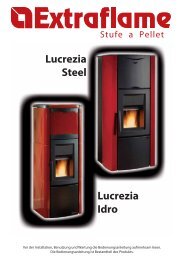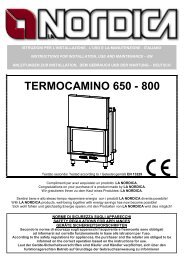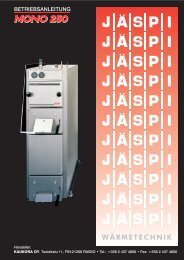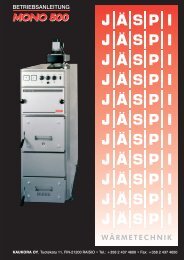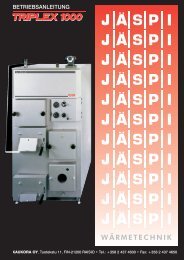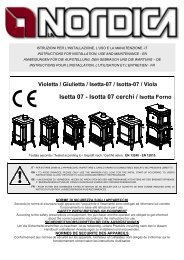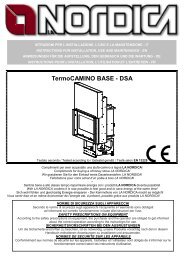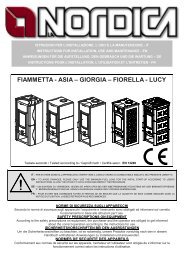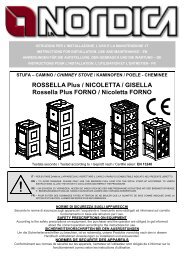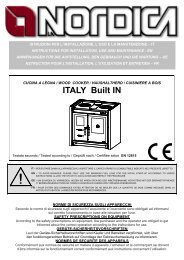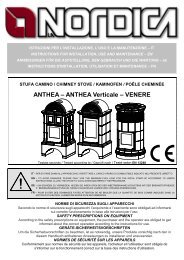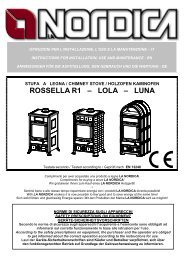TERMOSUPREMA Compact - DSA
TERMOSUPREMA Compact - DSA
TERMOSUPREMA Compact - DSA
Create successful ePaper yourself
Turn your PDF publications into a flip-book with our unique Google optimized e-Paper software.
Thermocooker – <strong>TERMOSUPREMA</strong> <strong>Compact</strong> <strong>DSA</strong><br />
6. CONNECTION TO THE CHIMNEY<br />
Cookers with automatic door closing (type 1) must operate, for safety reasons, with the furnace door closed (except<br />
during the fuel loading or ash removal phases).<br />
Cookers with non-automatic door closing (type 2) must be connected to their own flue.<br />
Operation with doors open is only allowed when supervised.<br />
The connection pipe to the flue must be as short as possible, straight and watertight.<br />
Connection must be carried out with stable and robust pipes (we recommend a thickness of 2 mm) and be<br />
hermetically secured to the flue. The internal diameter of the connection pipe must correspond to the external<br />
diameter of the cooker flue gas exhaust stub pipe (DIN 1298).<br />
CAUTION: if the connection passes particular compounds of flammable material, in the radius of 20cm around the<br />
pipe, all flammable material must be replaced by fireproof, heat resistant materials.<br />
For correct appliance operation, it is essential that sufficient air for combustion is introduced into the place of<br />
installation (see paragraph 7).<br />
IMPORTANT: the unused flue gas exhaust hole must be covered with its respective cap (See chapter 19).<br />
The chimney pressure (DRAUGHT) must be at least 17 Pascal (=1.7 mm water). The measurement must always be<br />
carried out when the appliance is hot (nominal calorific power). When the pressure exceeds 20 Pascal (2 mm water),<br />
it is necessary to reduce it through the installation of an additional draught regulator (butterfly valve) on the exhaust<br />
pipe or in the chimney.<br />
7. AIR FLOW IN THE PLACE OF INSTALLATION DURING COMBUSTION<br />
As the thermocookers draw their combustion air from the place of installation, it is essential that in the place itself, a<br />
sufficient quantity of air is introduced. If windows and doors are airtight (e.g. built according to energy saving criteria),<br />
it is possible that the fresh air intake is no longer guaranteed and this jeopardises the draught of the appliance and<br />
your health and safety. It is therefore necessary to guarantee a supply of fresh air through an external air inlet placed<br />
near the appliance or by placing piping for combustion air which leads outside or to a nearby airy place, with the<br />
exception of the boiler room or garage (FORBIDDEN).<br />
The connection pipe must be smooth with a minimum diameter of 120 mm. It must have a minimum length of 4 m and<br />
have no more than three bends. If it is directly connected to the outside, it must be equipped with a suitable<br />
windbreak.<br />
The intake of air for combustion in the place of installation must not be obstructed during operation by the<br />
thermocooker. It is absolutely essential that in environments in which thermocookers are operated with a natural<br />
chimney draught, as much air as is necessary for combustion is introduced, i.e. up to 25 m³/hour. The natural<br />
recirculation of air must be guaranteed by some fixed openings to the outside. Their size is established by regulations<br />
regarding the subject. Ask for information from a chimneysweep. The openings must be protected with grills and must<br />
never be blocked up. An extractor hood (suction) installed in the same room or in a neighbouring one causes a<br />
depression in the environment. This causes the leakage of burnt gas (dense smoke, smell); it is therefore necessary<br />
to ensure a greater flow of fresh air.<br />
The depression of an extractor hood can, in the worst case scenario, transform the flue of the thermocooker<br />
into an external air inlet, resucking the flue gases into the environment with very serious consequences for<br />
persons.<br />
8. PERMITTED/FORBIDDEN FUELS<br />
The permitted fuels are wooden logs. Only dry wooden logs must be used (water content max 20%). The pieces of<br />
wood should have a length of about 30 cm and circumference of 15 - 18 cm max.<br />
The wood used as fuel must have a humidity content lower than 20% which is obtained with a drying time of at least<br />
one year (soft wood) or two years (hard wood) placing it in a dry, airy place (for example under roofing). Damp wood<br />
makes lighting more difficult, as a greater quantity of energy is necessary to make the water present evaporate. The<br />
humidity content also has the disadvantage, as the temperature goes down, of causing the water to condense first in<br />
the furnace and then in the chimney. Fresh wood contains about 60% H 2 O, therefore it is not suitable for burning.<br />
Among other things which cannot be burned: carbon residues, cuttings, bark waste and panels, wood which<br />
is damp or treated with varnishes, plastic materials; in this case, the appliance warranty is forfeited.<br />
Paper and cardboard must only be used for lighting. The combustion of rubbish is forbidden and would also<br />
damage the thermocooker and the flue, causing damage to health and, due to the bad smell, causing complaints from<br />
the neighbouring area.<br />
Wood is not a long-lasting fuel and therefore it is not possible to use the thermocooker for continuous heating during<br />
the night.<br />
Instructions for installation, use and maintenance – EN – Rev.00 29



